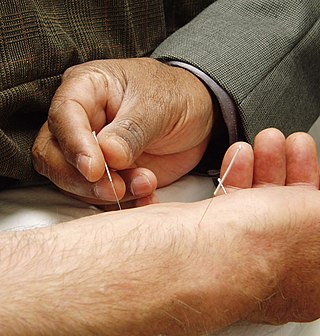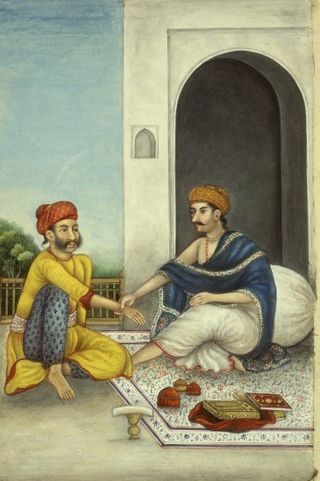
Acupuncture is a form of alternative medicine and a component of traditional Chinese medicine (TCM) in which thin needles are inserted into the body. Acupuncture is a pseudoscience; the theories and practices of TCM are not based on scientific knowledge, and it has been characterized as quackery. There is a range of acupuncture variants which originated in different philosophies, and techniques vary depending on the country in which it is performed, but can be divided into two main foundational philosophical applications and approaches, the first being the modern standardized form called eight principles TCM and the second an older system that is based on the ancient Daoist wuxing, better known as the five elements or phases in the West. Acupuncture is most often used to attempt pain relief, though acupuncturists say that it can also be used for a wide range of other conditions. Acupuncture is generally used only in combination with other forms of treatment.

Traditional Chinese medicine (TCM) is an alternative medical practice drawn from traditional medicine in China. It has been described as "fraught with pseudoscience", with the majority of its treatments having no logical mechanism of action.

Wuxing, usually translated as Five Phases or Five Agents, is a fivefold conceptual scheme that many traditional Chinese fields used to explain a wide array of phenomena, from cosmic cycles to the interaction between internal organs, and from the succession of political regimes to the properties of medicinal drugs. The "Five Phases" are Fire, Water, Wood, Metal or Gold, and Earth or Soil. This order of presentation is known as the "Days of the Week" sequence. In the order of "mutual generation", they are Wood, Fire, Earth, Metal, and Water. In the order of "mutual overcoming", they are Wood, Earth, Water, Fire, and Metal.
The zàng-fǔ organs are functional entities stipulated by traditional Chinese medicine (TCM). They constitute the centrepiece of TCM's general concept of how the human body works. The term zàng (脏) refers to the organs considered to be yin in nature – Heart, Liver, Spleen, Lung, Kidney – while fǔ (腑) refers to the yang organs – Small Intestine, Large Intestine, Gall Bladder, Urinary Bladder, Stomach and Sānjiaō.
The model of the body in traditional Chinese medicine (TCM) has the following elements:
Jīng is the Chinese word for "essence", specifically kidney essence. Along with qì and shén, it is considered one of the Three Treasures of traditional Chinese medicine or TCM.
The Liver is one of the zàng organs stipulated by traditional Chinese medicine (TCM). It is a functionally defined entity and not equivalent to the anatomical organ of the same name.
The Heart is one of the zàng organs stipulated by Traditional Chinese Medicine (TCM). It is a functionally defined entity and not equivalent to the anatomical organ of the same name.
The Spleen is one of the zàng organs stipulated by traditional Chinese medicine (TCM). It is a functionally defined entity and not equivalent to the anatomical organ of the same name.
According to traditional Chinese medicine, the kidney refers to either of the two viscera located on the small of the back, one either side of the spine. As distinct from the Western medical definition of kidneys, the TCM concept is more a way of describing a set of interrelated parts than an anatomical organ. In TCM the kidneys are associated with "the gate of Vitality" or "Ming Men". A famous Chinese doctor named Zhang Jie Bin wrote "there are two kidneys,, with the Gate of Vitality between them. The kidney is the organ of water and fire, the abode of yin and yang, the sea of essence, and it determines life and death."
The lungs is one of the zang organs described in traditional Chinese medicine. It is a functionally-defined entity and not equivalent to the anatomical organ of the same name.
The large intestine is one of the fu organs stipulated by traditional Chinese medicine (TCM). As distinct from the Western medical concept of large intestine, this concept from TCM is more a way of describing a set of interrelated parts than an anatomical organ. It is a functionally defined entity and not equivalent to the anatomical organ of the same name.

The meridian system is a concept in traditional Chinese medicine (TCM). Meridians are paths through which the life-energy known as "qi" (ch'i) flows.

In Chinese martial arts, there are fighting styles that are modeled after animals.

Pulse diagnosis is a diagnostic technique used in Ayurveda, traditional Chinese medicine, traditional Mongolian medicine, Siddha medicine, traditional Tibetan medicine, and Unani. Although it once showed many positive results, it no longer has scientific legitimacy, but research continues and is ill-defined in some derived text, and is subjective.
Blood stasis (BS) is a concept in traditional Chinese medicine (TCM), described as a slowing or pooling of the blood due to a disruption of heart qi. Blood stasis is also described by practitioners of TCM in terms of yin deficiency, qi deficiency and qi stagnation. For non-practitioners of TCM it is sometimes explained in terms of hematological disorders such as hemorrhage, congestion, thrombosis or local ischemia, and in terms of tissue changes. TCM practitioners believe it is an important underlying pathology of many disease processes despite the fact that objective, consistent methods for measuring the presence of blood stasis syndrome are not readily available. Blood stasis is associated with justifications for acupuncture and herbal treatments.
Hara. In the Japanese medical tradition and in Japanese martial arts traditions, the word Hara is used as a technical term for a specific area (physical/anatomical) or energy field (physiological/energetic) of the body. An alternative Japanese reading of the character is Fuku, the Chinese reading is Fu.
Fu's Subcutaneous Needle (FSN), invented by Dr. Zhonghua Fu in 1996, is an innovation for the treatment of myofascial pain and trigger points based on the research and clinical findings of Dr. D. Simons and Dr. Janet G. Travell.

Tongue diagnosis in Chinese Medicine is a method of diagnosing disease and disease patterns by visual inspection of the tongue and its various features. It is one of the major diagnostic methods in Chinese Medicine since the time of the Yellow Emperor's Inner Classic. It is considered a part of the “Inspection” method within the four methods of diagnosis. Practitioners claim that the tongue provides important clues reflecting the conditions of the internal organs. Like other diagnostic methods in Traditional Chinese Medicine, tongue diagnosis is based on the “outer reflects the inner” principle, which is that external structures often reflect the conditions of the internal structures and can give us important indications of internal disharmony.







